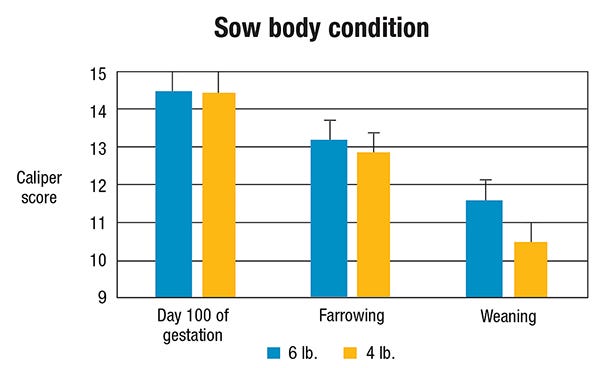January 5, 2016

Piglet quality is extremely important in maximizing a hog farmer’s income. Still, many will debate if increasing feed intake in late gestation to improve pig quality will bring enough return on investment.
Past research has shown that increasing feed intake in late gestation, commonly referred to as bump feeding, improves piglet birth weight in gilts but generally not in sows. However, bump feeding has been shown to increase colostrum production. Research at North Carolina State University examined if bump feeding in late gestation would have a positive impact on piglet quality.
The research team randomly assigned 67 parity 2 Landrace and Large White crossed sows to two different groups. One group received 4 pounds of feed from 100 days of gestation to farrowing, while the other group received 6 pounds. Gestation diets were formulated to 0.68% total lysine and 1,354 kcal of metabolizable energy per pound. All other nutrients met or exceeded National Research Council 2012 requirements for swine. All sows farrowed in late June of 2015 and were housed in individual gestation stalls with ad libitum access to water and natural ventilation. Piglets were individually weighed and identified within one day of birth and at 21 days of age. All reproductive traits were calculated as those of the biological dam.
Results
Results from the current study suggest bump feeding in late gestation does not increase piglet birth weight in multiparous sows, but it would improve the number of quality weaned piglets and sow body condition.
Nevertheless, bump feeding in late gestation did not impact total number born (13.08 vs. 13.05), total litter birth weight (32.3 vs. 32.5 pounds), average piglet birth weight (2.55 vs. 2.55 pounds) or birth weight coefficient of variation (21.2% vs. 20.0%) when compared to sows fed 4 pounds. Yet, at weaning bump feeding numerically improved litter size (9.71 vs. 9.14), litter weaning weight (122.1 vs. 111.4 pounds), average weaning weight (12.80 vs. 11.87 pounds), weaning weight coefficient of variation (21.3% vs. 18.7%) and piglet survival (73.6% vs. 71.8%). Collectively, the bump feeding treatment tended to wean more quality weaned piglets (piglets weighing greater than 7 pounds) than those fed 4 pounds (9.59 vs. 8.56).
In addition, sow body condition was monitored at the last rib with the sow body condition caliper throughout gestation and lactation. Sow caliper scores of 9 to 11, 12 to 15 and 16 to 18 correspond to traditional body condition scores (on a 1-to-5 scale) of 2, 3 and 4, respectively. Sows lost body condition from day 100 of gestation to farrowing and from farrowing to weaning. Sows that were bump fed in late gestation lost numerically less body condition from day 100 of gestation to farrowing and significantly less from day 100 of gestation to weaning (see chart). Overall, results from the study suggest bump feeding in the last two weeks of gestation does not increase piglet birth weight in multiparous sows but would improve the number of quality weaned piglets and sow body condition. This management strategy would be easy to implement on most commercial farms. Assuming a weaned pig cost of $34 ($33 x 1.03 increase in quality weaned pigs) and feed cost of $3.92 (14 cents per pound x 28 pounds), the calculated return on investment is $8.70 for every $1 spent.
Overall, results from the study suggest bump feeding in the last two weeks of gestation does not increase piglet birth weight in multiparous sows but would improve the number of quality weaned piglets and sow body condition. This management strategy would be easy to implement on most commercial farms. Assuming a weaned pig cost of $34 ($33 x 1.03 increase in quality weaned pigs) and feed cost of $3.92 (14 cents per pound x 28 pounds), the calculated return on investment is $8.70 for every $1 spent.
For more information, contact Knauer at 630-639-9263 or [email protected]. The research project was made possible through a collaborative effort with the North Carolina Department of Agriculture Tidewater Research Station.
You May Also Like



